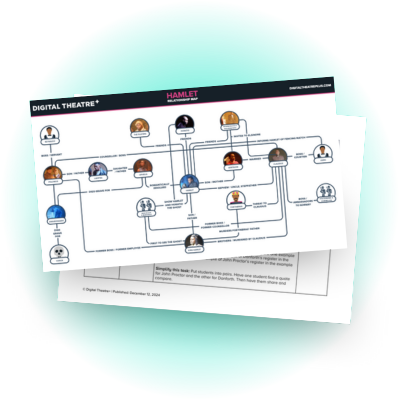Teach Hamlet
William Shakespeare's most famous tragedy is considered to be one of the greatest and most influential works of literature in history.
Digital Theatre+ helps you bring Hamlet to life in the classroom with high-quality productions, lesson plans, interactive resources, and more...
Paapa Essiedu (Hamlet) | Hamlet (RSC) | © Manuel Harlan
Explore Hamlet on Digital Theatre+
- 5Productions
- 20Video resources
- 16Written resources
Light up your classroom with engaging resources made by teachers, for teachers. Get in touch for a complete overview.
|
|
The RSC, 2016 Captured live in Stratford-upon-Avon, Simon Godwin's fresh retelling, set in an unnamed African state, sees Paapa Essiedu shine in the title role, becoming the first Black actor to play Hamlet for the RSC. "There is something spiritually refreshing about this new RSC Hamlet." – The Guardian ★★★★ |
|
|
Stratford Festival, 2022 Captured live at the Festival Theatre in October 2022, Peter Pasyk's adaptation stars Amaka Umeh, the first artist of African descent and liminal gender experience to play Hamlet at the Stratford Festival. "Starring Amaka Umeh, this modernized production of Shakespeare's tragedy is a bold and exciting presentation of the classic tale." – Intermission Magazine |
|
|
Tara Arts, 2016 Captured live at Tara Theatre in south London, this production marked the first time an all-black cast presented Shakespeare's classic tragedy in the UK. The seminal performance is followed by a Q&A session with director Jeffery Kissoon and Jatinder Verma MBE, Artistic Director of Tara Arts. "It offers a clear telling of the Hamlet story, but they have added another layer of mystery too." – British Theatre Guide |
|
|
Stratford Festival, 2016 Shakespeare's masterpiece unfolds in this acclaimed production from Stratford Festival, filmed live in 2016. Jonathan Goad plays the tortured prince, while Seana McKenna and Geraint Wyn Davies bring to life the couple that betrayed him. "In Jonathan Goad we have a quick-witted, intelligent, passionate, impetuous Hamlet who is not so much indecisive as he is able to see both sides of a dilemma." – Stratford Festival Reviews |
Interviews & Documentaries
- Directing the National: Nicholas Hytner with Tom Morris
- Kelly Hunter on Shakespeare
- Shakespeare's Women Today: Harriet Walter in Conversation with Carol Rutter
E-learning Videos
- Unlocking Literary Devices in Hamlet
- Unlocking Character: Hamlet
- Shakespeare in Rehearsal
- In Defence of Character: Hamlet
Essays
- Hamlet on Film: A Critical Introduction
Study Guides
- Hamlet: Interactive Playtext
- Unlocked: Hamlet
- Shakespeare in Rehearsal: A Guide to the Exercises
Hamlet Lesson Plans
- Practical Workshop Guide
- UK English & Drama: Hamlet
- US ELA & Theatre: Hamlet

What is Hamlet about?
Prince Hamlet sets out to avenge his beloved father's death at the hand of his uncle, Claudius, who has married the Queen and seized the crown. As he spirals, Hamlet's grief and madness have permanent, immutable consequences for the Kingdom of Denmark.
The play reflects the turbulent time Shakespeare was living in, where there was a growing struggle between the new and old ways of doing things. We see this clearly in the character of Hamlet, an intelligent young man who pursues violent and bloody revenge.
Explore Key Themes & Characters
Turn passive learning into active engagement with fun and dynamic resources on core literary texts like Hamlet, including in-depth analysis of key themes, characters, and literary techniques. Explore the full DT+ library with a free trial.
Key Themes
Madness plays a very important role in Hamlet, and Shakespeare uses it as a plot device across the play - it propels the story forward and drives the action.
In Act 1, Hamlet takes up an 'antic disposition. This means he will pretend to be mad. He plans to do this to protect himself while he attempts to find out if his uncle murdered his father.
Shakespeare is not afraid of depicting strong, ambitious women. So why are the women in Hamlet so... weak?
Gender roles were very strict in 16th and 17th century England. The society was a patriarchy, which means it was designed by and for the benefit of men. As women had very few rights, a 'good' father' would make sure that his daughter was protected against predatory and cruel men.
We see this attitude in Hamlet, where in Act 1 Scene 3, Laertes and Polonius both warn Ophelia against Hamlet.
The 17th century was part of the Renaissance period, where the revenge tragedy was one of the most popular types of violent play.
Revenge tragedies were messy, bloody affairs. They usually involved a man who was wronged taking up revenge against the perpetrator - these plays could often be seen as a challenge to governmental authority.
The Spanish Tragedy is one of the pioneering pieces of revenge tragedy, and set up a lot of the common features of the genre, including the 'play-within-a-play' and ghosts.
Key Characters
"To be or not to be, that is the question." (Act 3, Scene 1)
Hamlet is the young Prince of Denmark who has returned home after the death of his father. Upon arrival, he learns that his mother has quickly become remarried to his uncle, Claudius, who is now declared king.
Hamlet sees the ghost of his dead father, who tells him that Claudius murdered him and asks for vengeance.
He then pretends to be mad to uncover his father's murderer, and this desire for revenge leads to tragedy.
"A little more than kin, and less than kind." (Hamlet about Cladius, Act 1 Scene 2)
Claudius is Hamlet's uncle and the new King of Denmark. He kills his brother to become the king, and then marries his sister-in-law.
At the beginning of the play, Claudius seems to be a confident and relaxed ruler. However, this changes as the play progresses, and he becomes increasingly scheming and paranoid. He worries that his nephew knows what he has done, and becomes suspicious of Hamlet's strange behaviour.
"God hath given you one face, and you make yourself another." (Hamlet on Ophelia, Act 3 Scene 1)
Ophelia is Hamlet's love interest and a tragic heroine. She is the daughter of Polonius, and Laertes's sister.
Early in the play, we learn that she has received tokens of love and affection from Hamlet. However, when she is told to break off her relationship with Hamlet, she makes no attempt to protest.
Over the course of the play, Ophelia becomes increasingly isolated, and when her father dies, she slips into a state of madness, falling into the river and drowning - with many believing her death to be a suicide.
This overview is taken from our Unlocked Study Guide, which covers key context, characters, themes, and literary devices of the text.
Why did Shakespeare write Hamlet?
The story of Hamlet is very old, and there are two main texts that Shakespeare may have based Hamlet on: Thomas Kyd's Ur-Hamlet, and the story of Amleth, the son of Horvendill, King of the Jutes, who is documented in the 12th century Gesta Danorum (Deeds of the Danes).
It is also worth noting that Shakespeare had a son called Hamnet, who died in 1596 at 11 years old. Academics have debated how much this affected his work: could Shakespeare's grief have allowed him to depict sorrow and loss in an authentic way? Is the madness that Hamlet feels a reflection of his loss?
Extract: Unlocked Study Guide: Hamlet on DT+.
Making Shakespeare Cool | On-Demand Webinar
Get access to panel discussions, live teaching demonstrations, and ready-to-use lesson plans all designed to help you make Shakespeare's works and language more accessible (and fun!).
Shakespeare Starter Pack | Free Resource
Engage your students in the Shakespeare play of your choice (using practical examples from Hamlet) with this easy-to-use Shakespeare Starter Pack!


















